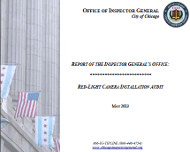Article from: www.thenewspaper.com/news/41/4101.asp
5/15/2013
Chicago, Illinois Inspector General Rejects Red Light Camera Justification
City audit shows Chicago, Illinois unable to justify red light cameras as a safety tool.
 There is no evidence that the world's largest red light camera program is operated as a safety program, according to a report released Tuesday by the inspector general for the city of Chicago, Illinois. The independent investigation comes as Redflex Traffic Systems continues to operate every aspect of the automated ticketing program despite Mayor Rahm Emanuel's promise to cut ties with the Australian firm.
There is no evidence that the world's largest red light camera program is operated as a safety program, according to a report released Tuesday by the inspector general for the city of Chicago, Illinois. The independent investigation comes as Redflex Traffic Systems continues to operate every aspect of the automated ticketing program despite Mayor Rahm Emanuel's promise to cut ties with the Australian firm.
Earlier this year, Redflex was caught in a $2 million bribery scheme designed to ensure Windy City officials would continue adding new cameras to boost the company's bottom line. The audit results are consistent with the suggestion that the locations for the new cameras were selected for the benefit of Redflex, not city residents.
"CDOT [the Chicago Department of Transportation] was unable to substantiate its claims that the city chose to install red-light cameras at intersections with the highest angle crash rates in order to increase safety," the report found. "Neither do we know, from the information provided by CDOT, why cameras in locations with no recent angle crashes have not been relocated, nor what the city's rationale is for the continued operation of any individual camera at any individual location."
The city gave Redflex $19.1 million for 384 cameras stationed at 190 intersections. Redflex has no financial incentive to issue additional tickets because it is paid the same $52,740 annual fee for each camera whether the location issues 328 citations or 19,805 (the lowest and highest volumes recorded at an intersection, respectively). In 2012, Redflex issued 612,278 tickets, collecting $71,943,053 in revenue.
Redflex offers a turn-key operation, leaving municipalities with no true responsibilities. So when the inspector general asked for crash data that might justify the cameras, Chicago responded that it does not collect the sort of reliable data that the audit requested. An independent analysis conducted by a University of Chicago adjunct professor in 2010 found no accident reduction where cameras were used (view report). The city also failed to provide any documentation that the yellow signal timing at the photo enforced locations is appropriate for traffic conditions. Chicago just uses a blanket 3 seconds for intersections with a 30 MPH posted speed limit and 4 seconds for 35 MPH intersections.
"We found a lack of basic recordkeeping and an alarming lack of analysis for an ongoing program that costs tens of millions of dollars a year and generates tens of millions more in revenue," the report stated.
The inspector general recommended the city come up with guidelines regarding selection of camera locations that would allow independent verification of whether continued camera use makes sense. When Chicago names another vendor to take over the red light camera program, Redflex will walk away having earned $106 million since the program began.
A copy of the audit report is available in a 1.1mb PDF file at the source link below.
Source: Red light camera installation audit (Inspector General, City of Chicago, 5/14/2013)
Permanent Link for this item
Return to Front Page
 There is no evidence that the world's largest red light camera program is operated as a safety program, according to a report released Tuesday by the inspector general for the city of Chicago, Illinois. The independent investigation comes as Redflex Traffic Systems continues to operate every aspect of the automated ticketing program despite Mayor Rahm Emanuel's promise to cut ties with the Australian firm.
There is no evidence that the world's largest red light camera program is operated as a safety program, according to a report released Tuesday by the inspector general for the city of Chicago, Illinois. The independent investigation comes as Redflex Traffic Systems continues to operate every aspect of the automated ticketing program despite Mayor Rahm Emanuel's promise to cut ties with the Australian firm.